
Antidesma is a genus of tropical plant in the family Phyllanthaceae formally described by Linnaeus in 1753. It is native to tropical Africa, S + E + SE Asia, Australia, and various oceanic islands. The greatest diversity occurs in Southeast Asia.

Olea is a genus of about 40 species in the family Oleaceae, native to warm temperate and tropical regions of the Middle East, southern Europe, Africa, southern Asia, and Australasia. They are evergreen trees and shrubs, with small, opposite, entire leaves. The fruit is a drupe. Leaves of Olea contain trichosclereids.

Canarium is a genus of about 100 species of tropical and subtropical trees, in the family Burseraceae. They grow naturally across tropical Africa, south and southeast Asia, Indochina, Malesia, Australia and western Pacific Islands; including from southern Nigeria east to Madagascar, Mauritius, Sri Lanka and India; from Burma, Malaysia and Thailand through the Malay Peninsula and Vietnam to south China, Taiwan and the Philippines; through Borneo, Indonesia, Timor and New Guinea, through to the Solomon Islands, Vanuatu, New Caledonia, Fiji, Samoa, Tonga and Palau.

Dysoxylum is a flowering plant genus of trees and shrubs from the mahogany family, Meliaceae.
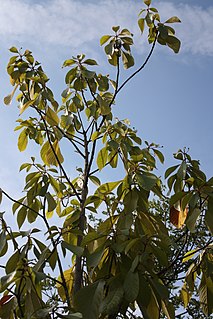
Phoebe is a genus of evergreen trees and shrubs belonging to the Laurel family, Lauraceae. There are 75 accepted species in the genus, distributed in tropical and subtropical Asia and New Guinea. 35 species occur in China, of which 27 are endemic. The first description of the genus was of the type species P. lanceolata made in 1836 by Christian Gottfried Daniel Nees von Esenbeck in Systema Laurinarum, p. 98.
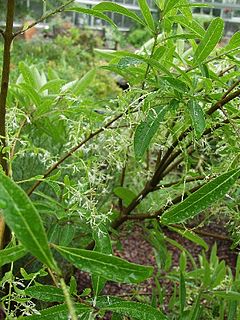
Chionanthus, common name: fringetrees, is a genus of about 150 species of flowering plants in the family Oleaceae.

Pothos is a genus of flowering plants in the family Araceae. It is native to China, the Indian Subcontinent, Australia, New Guinea, Southeast Asia, and various islands of the Pacific and Indian Oceans.

Barringtonia is a genus of flowering plants in the family Lecythidaceae first described as a genus with this name in 1775. It is native to Africa, southern Asia, Australia, and various islands of the Pacific and Indian Oceans. The genus name commemorates Daines Barrington.
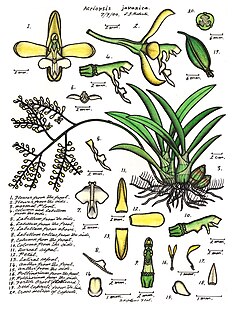
Acriopsis, commonly known as chandelier orchids or 合萼兰属 is a genus of flowering plants in the family Orchidaceaes. Orchids in this genus are epiphytic herbs with spherical or cylindrical pseudobulbs, creeping, branched rhizomes, thin white roots, two or three leaves and many small flowers. The flowers are non-resupinate with the lateral sepals joined along their edges and have spreading petals and a three-lobed labellum. The column has projections that extend hood-like beyond the anther.

Anodendron is a genus of plant in the family Apocynaceae first described as a genus in 1844. It is native to China, the Indian Subcontinent, Southeast Asia, New Guinea, and some islands of the western Pacific.
- Anodendron affine(Hook. & Arn.) Druce - China, Japan, Ryukyu Islands, Philippines, Vietnam, Laos, Thailand, Myanmar, Bangladesh
- Anodendron axillareMerr. - Philippines, Borneo, W Malaysia, Java, Sumatra
- Anodendron benthamianumHemsl. - Taiwan
- Anodendron borneense(King & Gamble) D.J.Middleton - Borneo, Palawan
- Anodendron candolleanumWight - Thailand, W Malaysia, Borneo, Java, Sumatra, Philippines
- Anodendron coriaceum(Blume) Miq. - Thailand, W Malaysia, Borneo, Java, Bali, Lombok, Timor, Flores
- Anodendron gracile(King & Gamble) D.J.Middleton - Borneo, Palawan, W Malaysia
- Anodendron howiiTsiang - Guangxi, Hainan
- Anodendron nervosumKerr - Yunnan, Assam, Laos, Thailand, Vietnam, Java, Sumatra
- Anodendron oblongifoliumHemsl. - Borneo, Philippines, Maluku, New Guinea, Bismarck Archipelago, Solomon Islands, Vanuatu
- Anodendron paniculatum(Roxb.) A.DC. - India, Bangladesh, Sri Lanka, Andaman & Nicobar Is, Malaysia, Indonesia, Philippines
- Anodendron pauciflorumHook.f - Borneo, W Malaysia, Sumatra
- Anodendron punctatumTsiang - Cambodia, Thailand, Guangxi, Hainan, Sichuan
- Anodendron seramenseD.J.Middleton - Maluku
- Anodendron tubulosum(Ridl. ex Burkill & M.R.Hend.) D.J.Middleton - W Malaysia, Sumatra
- Anodendron whitmoreiD.J.Middleton - Maluku, New Guinea, Solomon Islands
- Anodendron wrayiKing & Gamble - W Malaysia
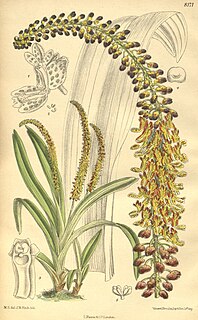
Mycaranthes is a genus of orchids. It was previously considered as a synonym of the genus Eria, but eventually it has become an accepted name. Its species are native to Southeast Asia, China, the Himalayas and New Guinea.

Homalomena is a genus of flowering plants within the family Araceae. Homalomena are primarily found in southern Asia and the southwestern Pacific, but there are a few species that are known to be indigenous to Latin America. Many Homalomena have a strong smell of anise. The name derives apparently from a mistranslated Malayan vernacular name, translated as homalos, meaning flat, and mene = moon.

Scindapsus is a genus of flowering plants in the family Araceae. It is native to Southeast Asia, New Guinea, Queensland, and a few western Pacific islands. The species Scindapsus pictus is common in cultivation.

Pholidota, commonly known as rattlesnake orchids, is a genus of flowering plants from the orchid family, Orchidaceae. Plants in this genus are clump-forming epiphytes or lithophytes with pseudobulbs, each with a single large leaf and a large number of small, whitish flowers arranged in two ranks along a thin, wiry flowering stem that emerges from the top of the pseudobulb. There are about thirty five species native to areas from tropical and subtropical Asia to the southwestern Pacific.

Thelasis, commonly known as fly orchids, is a genus of flowering plants from the orchid family, Orchidaceae. Plants in this genus are usually epiphytes, sometimes lithophytes or rarely terrestrials. Some species have pseudobulbs with up to three leaves, whilst others have several leaves in two ranks. A large number of small, white or greenish yellow flowers are borne on a thin, arching flowering stem. There are about thirty species, distributed from tropical and subtropical Asia to the southwest Pacific.
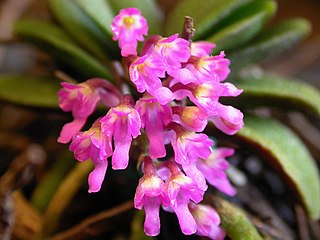
Schoenorchis, commonly known as flea orchids, or 匙唇兰属 , is a genus of flowering plants from the orchid family, Orchidaceae. Plants in this genus are small epiphytes with thin roots, thin leafy stems with leaves in two ranks and tiny fragrant, almost tube-shaped flowers with a prominently spurred labellum. There are about twenty five species found from tropical and subtropical Asia to the Western Pacific.
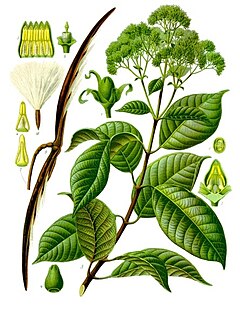
Urceola is a plant genus in the family Apocynaceae, first described as a genus in 1798. It is native to China, the Himalayas, Southeast Asia, and New Guinea.
- Urceola brachysepalaHook.f. - Borneo, Java, W Malaysia, Sumatra, Philippines
- Urceola elasticaRoxb. - Borneo, Java, W Malaysia, Sumatra
- Urceola huaitingii(Chun & Tsiang) Mabb. - Guizhou, Guangdong, Guangxi, Hainan
- Urceola javanica(Blume) Boerl. - Borneo, Java, Maluku, Sumatra, Sulawesi, New Guinea
- Urceola laevis(Elmer) Merr. - Palawan, Sabah, Sulawesi
- Urceola lakhimpurensis(S.K.Srivast. & Mehrotra) Karthik. & Moorthy - Assam
- Urceola latifolia(Pierre ex Spire) Mabb. - Laos, Thailand, Vietnam
- Urceola lucida(A.DC.) Benth. ex Kurz - Myanmar, Thailand, W Malaysia, Sumatra
- Urceola malayanaMabb. - Cameron Highlands of W Malaysia
- Urceola micrantha(Wall. ex G.Don) Mabb. - Fujian, Guangdong, Guangxi, Hainan, Sichuan, Taiwan, Tibet, Yunnan, Ryukyu Islands, Assam, Bangladesh, Bhutan, Arunachal Pradesh, Nepal, Cambodia, Laos, Thailand, Vietnam, Myanmar, W Malaysia
- Urceola minutiflora(Pierre) Mabb. - Cambodia, Laos, Thailand, Vietnam
- Urceola napeensis(Quint.) Mabb. - Laos, Thailand, Vietnam, Guangdong, Guangxi
- Urceola quintaretii(Pierre) Mabb. - Laos, Vietnam, Guangdong, Guangxi
- Urceola rosea(Hook. & Arn.) D.J.Middleton - Cambodia, Laos, Thailand, Vietnam, Laos, W Malaysia, Java, Sumatra, Fujian, Guangdong, Guangxi, Guizhou, Hainan, Hunan, Sichuan, Taiwan, Yunnan
- Urceola torulosaHook.f. - W Malaysia, Sumatra, Borneo
- Urceola tournieri(Pierre) Mabb. - Yunnan, Nepal, Bhutan, Assam, Laos, Myanmar, Thailand, Vietnam
- Urceola xylinabariopsoides(Tsiang) Mabb. - Hainan, Vietnam

Phrynium is a plant genus native to China, India, Southeast Asia, New Guinea and Melanesia. It was described as a genus in 1797.

Globba is a genus of plants in the ginger family. It contains about 100 species, native to China, the Indian Subcontinent, Southeast Asia, New Guinea, the Bismarck Archipelago and Queensland.
Micrechites is a genus of flowering plants in the family Apocynaceae, first described as a genus in 1857. It is native to China, the eastern Himalayas, Southeast Asia, Papuasia, and Queensland.


















